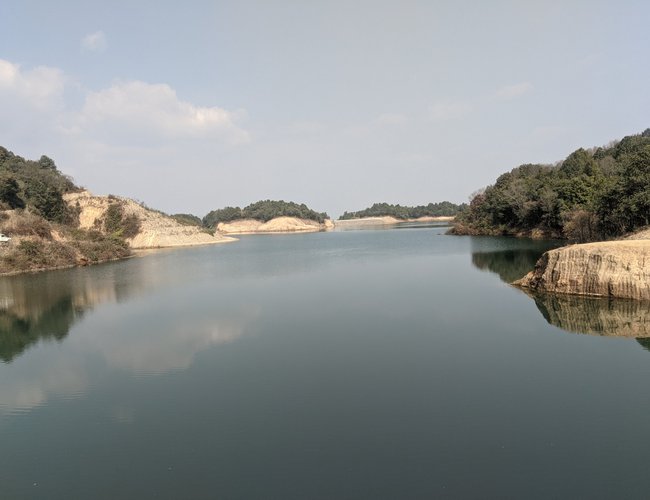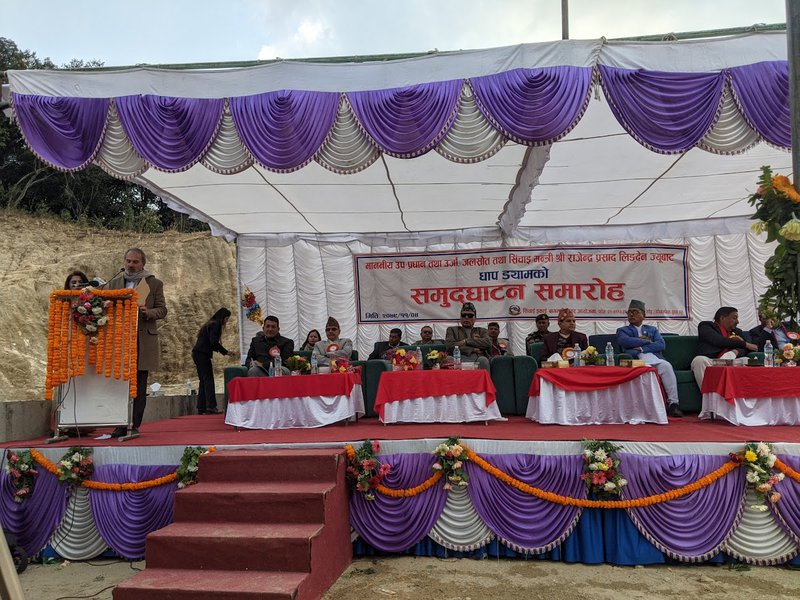
A very good morning to you all on this beautiful day here at Dhap Dam, I am extremely happy to see the Dhap Reservoir full of water in front of us, and the beautiful snow peaks in the distance. This truly reflects the natural beauty that adorns your country. And the Asian Development Bank is privileged to be one of the important development partners of Government of Nepal and Nepali people.

Some of you may know that before I came to Nepal as the country director, I was working in Nepal as a water resources specialist. It was during my time here then that I had the privilege of preparing the Bagmati River Basin Improvement Project, under which this Dhap Dam was built.
Looking back, it was in 2009, that the Government of Nepal, concerned with the degrading waterways of the Kathmandu Valley, endorsed the Bagmati Action Plan, adopting a vision of “a clean, green and healthy river system that is full of life and valued by all.” The Bagmati Action Plan provided a long list of interventions that collectively aimed to restore and conserve the river environment in the valley. Some of these interventions were already being implemented by the High Powered Committee for the Integrated Development of the Bagmati Civilization. But due to lack of financial and human resources, many of the planned interventions had not been implemented. ADB had already responded to the government’s requests to address the drinking water scarcity in Kathmandu Valley through several ADB-financed projects, one of them being Melamchi Water Supply Project. However, white these projects aimed to address the immediate human needs of drinking water, a gap remained to address the environment and culture priorities of the Holy Bagmati River which has been, and remains attached in the cycle of life of the denizens of this ancient, multi-ethnic and multi-cultural valley.
The policies and legislations related to water were also inadequate to address the emerging needs of an integrated water resources management approaches to govern Nepal’s rivers. Bagmati River suffered for a long time.
It was in this context of revitalizing the Bagmati River, that the vision for constructing Dhap Dam emerged. Dhap Dam would store water during the monsoon and release it during the dry season to augment the environmental flow of the Bagmati River. Along with this, the project incorporated a component to develop the river corridor as a green belt, and provide recreational space for Kathmandu’s denizens. The project also piloted watershed management interventions within the Shivapuri Nagarjun National Park to reduce the pressure on the Bagmati watershed; rainwater harvesting to recharge the Kathmandu’s ground waters, and social mobilization for solid waste management. But, more importantly, ADB provided technical assistance to the Government of Nepal to strengthen its water resources policy and amend the water resources act, in the context of federalization. These institutional reforms aimed to establish River Basin Organizations (RBOs), and empower them to decide on equitable water sharing for the development, for the environment and for cultural needs.
Honorable ministers, the approval of the National Water Resources Bill, which would provide the legal basis for the establishment of RBOs has been significantly delayed. I urge you too look into this with urgency to ensure Nepal’s water resources are managed in an equitable manner.
The contact for the construction of Dhap Dam, the first concrete-face rock fill dam in Nepal, was awarded to the consortium of Guanjhou-Lama-Raman in 2105 under a designed-built modality, with a target to complete the construction within 24 months. Unfortunately, the project faced many startup delays, first to get clearance for the tree cutting followed by delays in submission of the detailed designs of the dam and many contractual disputes over the next 8 years. Perhaps we were all too optimistic to believe that we could build a dam on the top of a 2500 meter ridge in two years!
Despite many odds, I am delighted today to be here among you in the inauguration ceremony of this beautiful dam and a reserved filled with precious water! This marks the beginning of further pipelined projects, such as Nagmati Dam which would add another 440 liters per second of water into the Bagmati river throughout the dry season. I believe that the lessons learned from Dhap Dam will be very useful to all stakeholders to build Nagmati Dam more efficiently. I would like to thank the entire team behind this endeavor to seek this project materialize from a dream 10 years ago to reality today.
I would specially like to express my sincere gratitude to the PIIU tam of Department of Water Resources and Irrigation (DWRI), who led the construction of Dhap Dam; and to HPCIDBC, who coordinated the overall BRBIP Project as the central project management unit. Their support in ensuring that sufficient budget was allocated for the project was a major challenge every year, but we are here today, finally, with a completed dam filled with water. I would also like to thank the engineer’s team for their support to the employer.
Last but not least, I would like to thank Raman construction for persevering through all odds, from construction disputes to the COVID-19 pandemic, to see that the project they took on to build, was indeed completed.
Honorable ministers and distinguished guests, I would like to emphasize again that the purpose of Dhap Dam was to augment that environmental flow of the Bagmati River, to serve the cultural value of Bagmati within the Kathmandu Valley. If water of this dam is not diverted to Bagmati River, the intended purpose of Dhap Dam will not be achieved. There is a need for the key stakeholders to discuss among themselves and agree on an amicable way forward, particularly on allocation of water, especially when Nagmati Dam will be constructed. While doing so, I would like to request the key stakeholders to consider Bagmati River, its users, and denizens of the Kathmandu Valley.
In parting, honorable ministers, and distinguished guest, please allow me to express from heart, that I am humbled to see not only the natural beauty that your country offers, but more importantly for me, the deep cultural values that you still keep alive in your country. The rivers that flow through the Kathmandu Valley are adorned with historic monuments with deep cultural values. Your culture has a deep affinity to the rivers from birth, until death. The vision of the Bagmati Action Plan of a “clean, green and healthy river system, that is full of life and valued by all, truly embraces that value of your society. This project contributes to that vision. But for that vision to truly materialize, it will take your belief in it and your perseverance to achieve it collectively as the citizens of a new Nepal.
Arnaud Cauchaois is the County Director of the Asian Development Bank’s Nepal Resident Mission.
Excerpt of the statement delivered at the inauguration ceremony program for the Dhap Dam construction work on February 16.

















